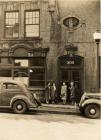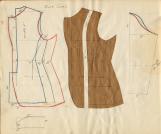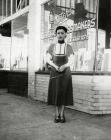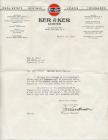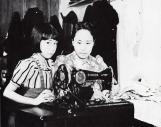15
For students looking to establish a career in dressmaking, a number of formal dressmaking schools taught one- to four- year programmes in everything from needlework to pattern layout to dress construction. To name a few, there were: the Women's Sewing School, the Marietta School of Costume Design, the Academy of Domestic Arts, and the Girls College of Practical Arts. A healthy competition between the schools for the recruitment of new students, is evident from articles and advertisements which ran in The New Canadian, the local Japanese Canadian newspaper. For example, a 1941 article for the Marietta School of Costume Design states:"Miss Haruko Morishita is the Nisei principal of the Marietta School of Costume Design, whose courses in dress designing, drafting and useful arts, are setting a new standard among Niseis in the city. So popular is the Marietta School that prospective students are urged to register immediately to be sure of a place in the classes."(7)
17
These schools provided comprehensive and individual instruction and awarded the students a diploma upon graduation. In a letter from Salinas, California where she now resides, Mary Otto (nee Ikeda) described her own training in a dressmaking school:"Before the war I studied dressmaking and tailoring at the Matsuzaki School. Craftwork with wool, embroidery, and cutwork were all part of the course for a diploma. My main interest was of course dressmaking and as my aspiration grew my dream and goal headed towards becoming a dress designer. I studied the proportions of sketching a figure and drew my ideas on paper to design and produce a garment. ... And so during the summer months when many of my friends went to the farms to pick strawberries and tomatoes, I walked Monday to Friday to the Matsuzaki School of Dressmaking and Tailoring."(8)
19
Drafting the dressmaking patterns, using curved and right-angled rulers, was a highly technical skill. The closely fitted and bias-cut fashions that were popular during the era demanded skill and precision in drafting the patterns. First designed on a small scale, the patterns were then transferred to full scale from which the fabric was cut. Students kept their pattern drafting books for ready reference; many of the women who assisted us with the display still have their pattern books today. Chie Oya, who studied dressmaking at the Slocan City internment camp, requested that we return her pattern book to her as soon as we could as she still occasionally uses it -- over 50 years after she first created it!21
Throughout the 1920s and 1930s, Japanese Canadian women established dressmaking shops and businesses. While we were researching the exhibition, we were fortunate to speak with a number of women who had owned and operated their own shops. Sayoko Hattori (nee Tanaka), purchased Bonnie Lass Dressmakers on Dunbar Street in Vancouver in 1936 when she was just 23 years old.(9) She had learned her dressmaking skills working for Yayoi Negishi in her corner shop at Broadway Street and Commercial Drive. Sayoko's business thrived and after she married, she and her husband expanded the shop to include dry cleaning. Another shopowner who told us her story was Ayako Kohara (nee Yasui), who, together with her sister, Shizue, established Sisters Cleaners and Dressmakers on Alma Street.(10) The two sisters worked side-by-side designing and sewing dresses for women in the neighborhood, while their father operated the cleaners. According to Charles H. Young and Helen R. Reid, in 1931, there were 81 Japanese Canadian cleaning and pressing businesses in Vancouver alone.(11) Invariably, these included alterations and dressmaking for which the women were responsible.23
For these and many other entrepreneurial Nikkei women, however, success was short-lived. In 1941, World War II erupted, dramatically changing the lives of all Japanese Canadians who lived along the West Coast. Discrimination and racial tensions that had been brewing for many years culminated in the forced evacuation of all persons of Japanese origin from the Coast. By October of 1942 the entire community was uprooted and sent to internment camps, ghost towns, road camps, or other isolated locations "east of the Rockies". All of the dressmaking businesses owned by Japanese Canadians in Vancouver closed. Although a few managed to sell their businesses before they were evacuated, most were forced to simply close their shops and leave.25
In the internment camps and other isolated locations, the need for sewing and dressmaking became paramount as families scrambled with few resources for adequate clothing. Many families were fortunate to have their treadle sewing machines with them -- necessary equipment as the often crude conditions meant having to live without electric power. One thing that struck us as we researched the exhibition was the resourcefulness of everyone at that time. In the face of a severe shortage of materials, everything that could be recycled, was: men's dress shirts became small shirts for boys or dresses for young girls; an adult overcoat became the material for children's parkas; rice and flour sacks became sheets, towels, and cushion covers. Tokuko Inouye recalls sewing outfits for her son from the "blackout fabric" her family used earlier in the war to block the light from the windows.26
Portrait of the Academy of Domestic Arts at Greenwood, BC, in 1945. Courtesy Ruth Hamaguchi.22 April 1945
Greenwood, BC
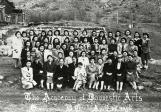
27
In many of the internment camps, dressmaking classes and academies that had been forced to close in the Vancouver area were once again established, some by former teachers and directors. As we worked on the exhibition and asked the community for assistance, we received many photographs of sewing classes from camps and ghost towns such as Tashme, Lemon Creek, Greenwood, Slocan City and East Lillooet. In a letter, Mary Otto described her attempts at establishing a makeshift dressmaking class in the Tashme internment camp:"Evacuation started and after a year of incarceration in Tashme I decided to share my knowledge in dressmaking with anyone interested. There were many as there was not a clothing store and the girls and young ladies and women were desiring to add new dresses to their wardrobe. I had a Singer sewing machine (treadle) which we were able to have shipped from Vancouver. We started our class on the kitchen table. ... Class time was very limited because at mealtime the table was needed.
As I received more requests from would be students we decided to convert the two bedrooms into sewing rooms by bringing down a flat board over the bed, converting it into a table. When not in use the board was hooked back against the wall and the bed was ready to use. One of the student's mother loaned out her machine in exchange for her daughter's lessons so with two machines we did all right with four or five students at a time in three shifts: morning, afternoon and evening.
How did we manage without electricity? Coal oil lamps were limited to two per family so we purchased extra lamps by mail order. Our house was well lighted up thanks to my father who had a job as the "Oil Man". I followed the same format of the Marietta School of Dressmaking and those who stayed long enough with my class were able to earn a diploma. After the war we went on our own way but I heard from time to time that the girls and some of the married women were able to find jobs or even supervisory positions in the clothing field."(12)
